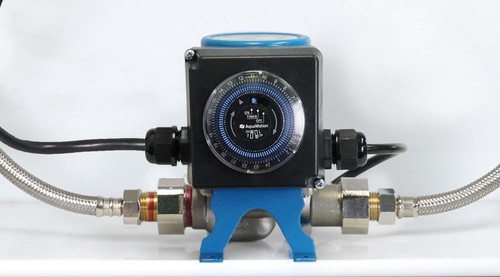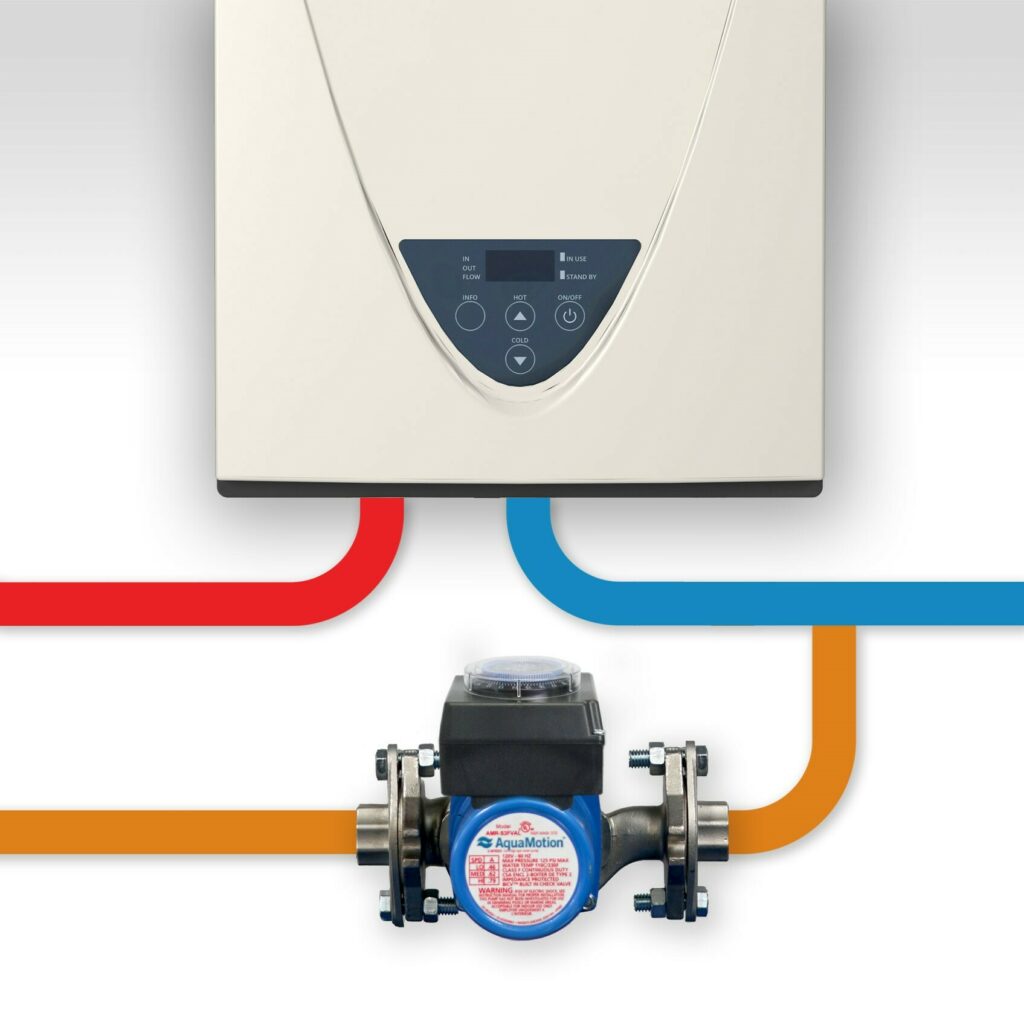Output, by sector and industry, provincial and territorial - industries
The ODR installs at the fixture furthest from the tankless hot water heater and acts in conjunction with a circulator to supply hot water on demand or with a built-in timer on the pump.
This pump is for use with single pipe, tankless hot water heaters without a built-in pump. It includes an AM6 circulator, built-in timer and an AquaMotion ODR valve (for under sink installation).
In addition, all of the moving parts are housed in a “Green Eco Cartridge Design”. It is the only field serviceable and replaceable cartridge available, making maintenance and replacement quick and easy.
Before looking at recirculating pumps, note what type of hot water heater you have. Tankless water heaters generally require higher power pumps, and should be taken into account. Most pumps may not have the necessary power to be compatible with upscale gas or electric tankless water heaters.
To reduce heating costs, most full recirculating pumps use sensors to shut off the flow when the hot water has made a complete loop. Some also incorporate timers that allow users to schedule the pump’s operation and shut it off during low-demand hours, such as at night or during working hours.
Hot water recirculation pumps come in two versions: Three pipe systems with a dedicated return line and two pipe systems that make use of a crossover valve.
This 3-speed circulator comes with a built-in mechanical timer and Aquastat. The 3 speeds allow it to be used with either a storage tank or tankless hot water heaters. The pump is rated for up to 125 PSI water pressure, with a maximum ambient water temperature of 104°F.
Unlike the full recirculating pump, this one uses the existing cold water line and a specially designed valve to return the unused hot water back to the heater.
The Zurn Wilkins DUXLC Dielectric Union is installed on potable water lines to protect against piping system deterioration caused by galvanic and stray current corrosion.
You can also view our complete selection of hot water recirculation pump kits from AquaMotion and Rinnai, catering to different water heaters, price points, and needs.
To make your selection easier, here’s a handy chart of the hot water recirculation systems we carry and their ideal use cases.
Some jurisdictions where water is scarce provide rebates on the purchase and installation costs of recirculating systems. For example, some cities in New Mexico provide a $100 rebate, while it can go up to $200 for some cities in Arizona.
The following navigation utilizes arrow, enter, escape, and space bar key commands. Left and right arrows move across top level links and expand / close menus in sub levels. Up and Down arrows will open main level menus and toggle through sub tier links. Enter and space open menus and escape closes them as well. Tab will move on to the next part of the site rather than go through menu items.
Cast iron may be more durable and longer lasting than aluminum. However, it is not recommended for potable water use since rust can develop in the system. Premium pumps use stainless steel, which combines the durability and longevity of cast iron with the rust-proof quality of aluminum.
A recirculation system considerably reduces the time it takes for water to heat up, providing users with instant hot water on tap.
These use a dedicated hot water return pipe connected to the plumbing system. It creates a loop from the water heater to the different fixtures, and back again. Any unused hot water gets shunted into this loop by the pump, so that hot water is always instantly available instead of being left in the main pipe to get cold.
The AquaMotion AMH3K-7 is designed to deliver hot water quickly at all points of use between the hot water tank and the farthest fixture that this pump is insta...
Based on the Energy Information Administration’s Office of Energy Consumption and Efficiency Statistics, heating water is the second largest use of energy in an average home (after space heating and cooling). A recirculation pump can lower the cost by reducing the amount of hot water needed.

Also called hot water recirculation pumps or simply circulating pumps, these dedicated pumps are connected to the water heater and return unused hot water back to the heater. Their purpose is twofold:
The AquaMotion AMH2K-R is designed for hot water heaters with a dedicated return line. It installs right into the return line near the tankless heater, and does not require power or room under any sink.
Other systems use temperature sensors that automatically activate the pump if the water in the line falls below a preset value. These are recommended for larger homes with more water fixtures or higher hot water demand.
This is a useful feature to have if your household has a peak hot water usage time, so you can limit the power needed for heating water only to peak hours. Timers are also recommended in states where electrical costs come at a premium.
The pump features a 24-hour mechanical timer with 15-minute increment tabs and built-in, non-adjustable Aquastat. The Aquastat will tell the pump to run when it senses the water at the fixture is starting to drop below 85°F and will run for about a minute or so until it reaches 105°F degrees and shuts off. The pump will run about 3 times per hour for less than 5 minutes.
The AMH3K-7 is designed for single pipe hot water tanks with no return line. As an under sink model, it is compact enough for most under sink spaces and installs quickly without any pipe cutting required: simply attach to the water hoses at the valve and plug in.
According to the EPA, the average American home wastes more than 3,650 gallons of water per year waiting for hot water to arrive at the point of use. A recirculation system cuts down on water losses by delivering nearly instant hot water for use instead of wasting water while waiting for it to heat up.
Some pumps have manual on/off buttons: these need to be switched on before using the faucet. These pumps are ideal for smaller homes where hot water demand is limited to a few fixtures, such a single bathroom.
But showers are one thing. Imagine cooking in the kitchen, and getting some egg or other foodstuff on your hand. You just need a quick 5-second spurt of hot water to wash off the gunk. Instead, you stand there for nearly half a minute with egg yolk on your hand, waiting for the water to heat up. Meanwhile, gallons of cool but perfectly clean water run down the drain.
Hot water recirculating pumps work by circulating hot water through the plumbing system, ensuring that hot water is readily available at the tap when needed. It uses temperature sensors to monitor the temperature of the water in the pipeline. Pumps can be run on a timer, triggered by a button or motion, or run all the time.
Recirculating pumps come in a wide variety of types and designs to accommodate different water heaters. Some of the things you should look for are:

My wife and I have lived in our house 39 years; we are presently using the 4th gas heated water tank (Rheem 4 years old), located in the “under house basement/garage.” I’m investigating having a professional install a hot water recirculating pump on the water heater. Do hot water recirculating pumps work the same with gas heated and electric heated water tanks? Do the ‘pros’ outnumber the ‘cons’ using with this system to get instant hot water?
A check valve stops water from going back to the return plumbing line. This way, it returns water in the line back to the water heater, reducing the time it takes to reach the faucet.
Since it doesn’t require a dedicated hot water return line, this is a more budget-friendly option. However, since the hot and cold water share the same pipe, cold water can sometimes come out lukewarm or take time to get cold. This can be a particular concern for homes equipped with an evaporative cooler.
The AquaMotion Recirculation Systems are the perfect retrofit solution for hot water quickly. As many homeowners know, you can turn on the faucet and wait for t...
The AquaMotion AMH2K-R is designed to deliver hot water quickly at all points of use between the hot water heater and the dedicated return line. The built-in pu...
Some pumps are equipped with timers, or can be programmed to operate only in periods when hot water demand is high (for example, they can automatically turn on during the morning and shut off during working hours). This cuts down on unneeded heating, and reduces costs and wear.

Having hot water on demand is a convenience that many of us take for granted. Imagine taking a shower on a cold winter morning, and you can instantly appreciate this luxury we have on tap, pun intended.




 8615510865705
8615510865705 
 8615510865705
8615510865705